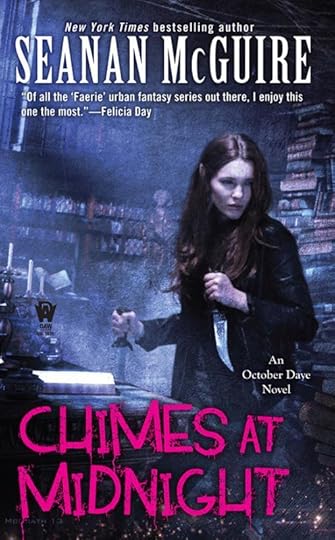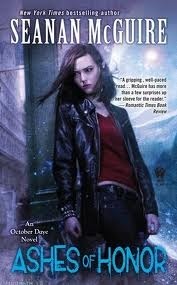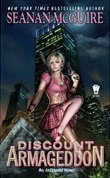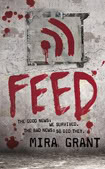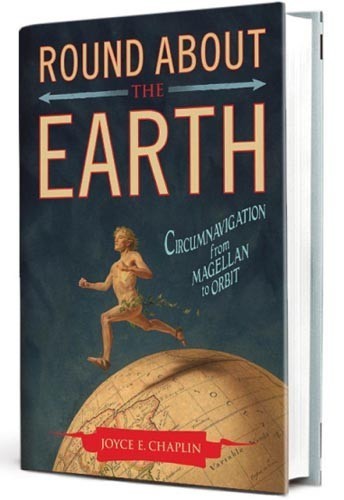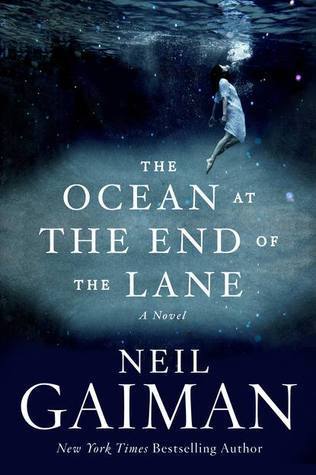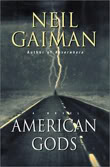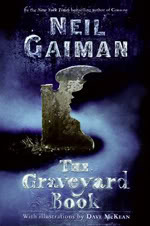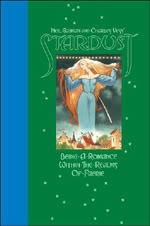Alex C. Telander's Blog, page 54
September 12, 2013
“Chimes at Midnight” by Seanan McGuire (DAW, 2013)
The seventh volume of the October Daye series, Chimes at Midnight, is your typical Toby Daye book, as things seem fine and semi-normal for the first few pages, and then take a lunge to the bizarre and fast-paced, as things heat up. However, this time the stakes seem higher than ever.
Toby and Tybalt, the King of Cats, are now an item and can’t keep their hands and paws off each other, smooching in dark corners and brightly-lit streets, to the point where it starts to grate on the reader, who wants to just get back to the story and adventure at hand. Dead changelings are showing up on the streets, the victims of an overdose of addictive and dangerous goblin fruit. Toby takes this problem to the Queen of Mists, who she’s pretty sure is behind it all and fueling the whole enterprise. But Toby is soon kicked out on her butt and told she must leave the queendom within three days, banished. And before she knows it, Toby finds herself on the receiving end of an attack of goblin fruit that puts her under its dangerous spell. Then there’s the question of the queen’s valid claim to the throne, which seems to be in doubt.
As usual, Toby has a lot to deal with, under the spell of the muddling goblin fruit, it’s a tough one for her and time is running out. Things kick into the predictable high gear readers have come to expect from the series, as Toby jumps from place to place to place at an outlandish rate, leaving the reader’s head spinning, and things get nice and easily solved each time, with little threat to the protagonist or her friends. The climaxes and conflicts of the book feel somewhat contrived and are too easily resolved, making it seem as if the book was written in a hurry. While the ending, although predictable, is worth it, the journey along the way leaves a lot to be desired for the reader who has come to enjoy this series.
Originally written on July 30, 2013 ©Alex C. Telander.
To purchase a copy of Chimes at Midnight from Amazon, and help support BookBanter, click HERE.
You might also like . . .


September 10, 2013
Book Report: Agatha Christie Returns, TV Looks To The Bookshelf For Ideas, Authors Handselling Their Work & More!
Kindle MatchBook and Clonefiles
A new chapter in the print book and ebook world that has them working together for a change.
10 New Fall Shows Based on Books
Ten new shows will be starting this fall and they’re all based on popular books and one that hasn’t even been published yet.
105 Years of Anne of Green Gables Covers
Anne of Green Gables has been around for a long time and has been released in many different editions, and here’s a roundup of the various covers.
[READ MORE . . .]


September 9, 2013
That’s What I’ve Been Saying All Along . . .
There are two programs starting up in the publishing world employing an idea that I’ve thought should’ve been done years ago, possibly around when ebooks started becoming readily available and sold. You see, that day was the day the war between ebooks and print books began, and there really didn’t need to be a war. It should’ve been more like one of those two-in-one books where you have one book on one cover, then you flip it over and have another book with another cover.
A symbiosis that wouldn’t have called for allies coming together to battle the enemy.
Kindle MatchBook will begin next month, offering to customers the option when they purchase certain print books to get the Kindle ebook edition for $0.99-$2.99 or even free. Now, this isn’t every print book Amazon currently offers, but it’s an important start that will hopefully grow and grow and make this program seem the normal thing and eventually be omnipresent with books and reading.
Angry Robot’s is also has its bundling Clonefiles program, which was given a trial run in Britain last year and is now coming to the US, where customers who buy a paperback from a participating independent bookstore, can get the ebook for free. Again, hopefully this is the start of something that will take the publishing world like wildfire and become a common facet in the near future.
In March of this year I published my column, Where’s the Digital Copy for Books?, where I explain my hope for the publishing future where print books and ebooks live happily together, where a customer buys a print book in a store or online and said customer automatically receives a free ebook copy, so that multiple people in a family can enjoy the same book at the same time.
I think this is the beginning of a beautiful friendship.


September 5, 2013
“God’s Facebook” by Najmus Saquib (Innovation and Integration Inc., 2012)
While Najmus Saquib earned his Ph D. in engineering, he is a philosopher at heart, with deep interests in literature, social dynamics and comparative religion. In God’s Facebook, Saquib sets out to show the evolution of God through the history of humanity, starting in early primitive times, and continuing up through the present and into the possible future. He does this partly with his own words, but also with quotes from many different sources, be they sacred texts, personal biographies, or even works of fiction. His goal is to show that with the many similarities in all religions, with how god is seen at the center, that people will see and understand this and feel that humanity is all one.
The book is divided up into chapters by time period, such as Chapter 3 – God is Born (250,000 to 2000 BC) or Chapter 4 – God Gives Us Religions (2000 to 1000 BC). In each chapter he covers that period in time with a short history of the religion and beliefs of the time, and what was changing. In every chapter there are numerous quotations from a variety of texts and people linked to the particular subject of that chapter. To break up the quotes, there are also “Coffee Breaks” and “Like” sections.
Saquib even addresses atheism in some chapters, though it doesn’t make much sense with the rest of the book, as the quotes are added in there as awkward pieces that don’t the puzzle of God’s Facebook. What feels missing from the book is a clear message. If Saquib is hoping to link humanity with just the quotes alone, that is not enough. It does show some of the numerous similarities with many religions, but as is true with many people of faith, they need guidance, and there seems little of it in God’s Facebook.
Originally written on February 13, 2013 ©Alex C. Telander.
To purchase a copy of God’s Facebook from Amazon, and help support BookBanter, click HERE.


September 3, 2013
Book Report: Obama Responds, Neil Gaiman’s Book Tour, and More

Fiction Affliction: Popular releases in fantasy for September.
Obama Responds: Obama responds to criticism from indie bookstores.
Live Stream Book Events: Independent bookstores are starting to stream signings and readings live online and then archiving.
New Kobo Tablet: Kobo unveils it’s new tablet and ereader, showing it’s still very much in the ereader and tablet game.
20 Cities in 80 Seconds: A Youtube video showing the highlights of Neil Gaiman’s book tour.
Harry Potter 15 Years Later: J. K. Rowling on Harry Potter fifteen years later and who she misses most.
I Hate Strong Female Characters: What’s not to be liked about the term “strong female character” and why.


August 29, 2013
“Round About the Earth” by Joyce E. Chaplin (Simon & Schuster, 2012)
There have been many books written about the notorious explorers from history, like Columbus, Magellan, Cook and even Darwin. There are also now a fair number of people who can make the claim that they have circumnavigated this globe. Joyce E. Chaplin presents readers with the first full history on those who have traveled around the world and told their story.
Divided into sections, Chaplin presents the series of historical tales starting with Magellan, giving the ups and downs of the journey. She points out that it wasn’t until the twentieth century that these round-the-world trips actually returned to their starting point with most of the crew still alive. All the greats make it into this book, such as Francis Drake, William Dampier, Louis-Antoine de Bougainville, and James Cook. When sea travel became safer, people like Charles Darwin made the journey, as well as some notable women like Lady Brassey.
With the advent of encompassing railroad travel and exotic cruise ships, round the world journeys became much more achievable and common for a lot of people. And with the advent of the space race, a new concept of circumnavigating the globe came into play, with an elite few achieving it. Chaplin has fun exploring these many journeys and why people seem driven to accomplish it. While her writing can get a little dry and long-winded at points, Round About the Earth still represents an interesting foray into this unique group of travelers.
Originally written on February 11, 2013 ©Alex C. Telander.
To purchase a copy of Round About the Earth from Amazon, and help support BookBanter, click HERE.


August 27, 2013
Book Report: Overstock Match, Remembering Dutch, Get Off Listening To Dickens & More

Remembering Elmore Leonard
A moving article from the San Francisco Chronicle on the passing of a literary great, Elmore Leonard.
Fall Books
Recommended scifi and fantasy reads for fall from IO9.
Dark Children’s Books
Eleven redesigned children’s book covers that reflect the dark stories within.
[CONTINUE READING . . .]


August 24, 2013
BabyBanter: The First Two Weeks

1. ARRIVAL 2. SLEEP 3. HARLEQUIN SYNDROME 4. THE STUMP
1. ARRIVAL

Our baby Owen arrived a week late, as we’d expected, weighing in at 8 lbs even, and while labor lasted about fifteen hours, only the last three were spent at the hospital with the delivery. Everything happened pretty fast and was really intense and before we knew it, my wife was being taken in a wheelchair to the recovery room, while I was wheeling a little crib with my newborn son in it.
It was really surreal.
We ended up spending two nights in the hospital which proved invaluable and vital in hindsight. My wife needed time for recovery from the accelerated delivery and we needed time to get breastfeeding down.
When we were discharged from the hospital, we were still using a nipple shield to facilitate breastfeeding and continue to do so. One of the worries of the nipple shield is that the baby doesn’t get enough milk. But working through our third week now, Owen has already surpassed his birth weight and I predict is about a pound over now. So that isn’t an issue.
But being able to spend a couple days and nights at the hospital were so important to get into the schedule of feeding and dealing with a newborn. And always having a trained nurse at our beck and call and bringing us food helped so much in getting us going with being parents.
There’s a fascinating article on postpartum practices around the world and how the US has the worse ones. In China, the mother gets to stay in a sort of hotel for a month and is looked after so all she has to focus on is her baby. In other countries help is always available, and often both parents are supported to be at home and raising their newborn.
In the US it’s all about getting you out of the hospital ASAP and then it’s usually just mom stuck at home having to do everything, while dad is back at work. After two weeks of living with a newborn, getting up every 2-3 hours for feeding, diaper changing, cleaning, making time for us to eat, and getting sleep where we can, we don’t really know how moms on their own do it. We know we’re incredibly fortunate to have both of us at home with Owen, and it’s certainly paying off, as we work together on everything, and tag team chores and jobs so that the other person gets a break and rest where possible.
We also know that while Owen is still very much a newborn who doesn’t really know what’s going on with everything, we have done plenty of skin to skin bonding, and he now knows who his mommy is, and who his daddy is.
2. SLEEP

The first week was really tough. The first night we got about three hours sleep, Then four on the second. Then five to six on the third. We now average about six to seven hours a night, if possible, even if it means sleeping in late and taking naps.
Now, to anyone, five hours and up sounds pretty decent for sleep, but it’s a whole different diaper pail of diapers when you’re getting up every 2-3 hours for feedings. These feedings can last anywhere from twenty minutes to over an hour. Then it’s getting Owen back to sleep: sometimes he crashes out pretty quickly, other times I have to walk with him and rock him to sleep which can take up to half an hour, and then I get to go back to sleep. And then it’s maybe two hours until the alarm goes off again or he wakes up and it’s time to do it all over again.
We’ve got our routine down pretty well now. We started with an alarm, but now Owen wakes up and starts fussing, and if that doesn’t wake us up, he’ll start crying. So I’ll unswaddle him and get him up and wide awake while my wife prepares for feeding. Then he feeds for as long as he wants, I take him and change him, and then he does another bout of feeding. Hopefully after that he’s feeling pretty tired and I swaddle him up again and put him down to sleep.
But newborns will be newborns, and often have problems getting themselves to sleep. So he’ll be breathing away in slumber land for five to ten minutes, and then shake himself awake and start crying. That’s my cue to pick him up and rock him and stroke him and do whatever I can to get him sleeping again. Usually he’ll drop into REM sleep pretty quickly, but I know this is light sleep for him that he can easily be woken (by himself) from, so it’s necessary to sit with him, continuing to rock and keep him sleeping, until he sleeps into a deeper sleep and that’s when I can put him back down in his crib to sleep until he wakes up hungry once more.
3. HARLEQUIN SYNDROME
This is a rare condition that occurs in less than 10% of newborns and is completely harmless but extremely alarming if you don’t know about it. In our case, we had no clue and were scared out of our wits when we first saw it, but fortunately the internet put our fears to rest.
Owen was born with jaundice, which is very common and occurs in about 70% of newborns, and is usually cured and cleared out of the baby system within a month, so long as he’s regular feeding and regularly pooping. But because of this, his skin color was an unhealthy-looking yellow.
During one of his feedings on our first night at home we saw that when he would be laid down on his side feeding, the complete bottom half of him — as if someone had drawn a line from the top of his head straight down his back along his spine to his bottom — was a deep red, while his top half was that jaundice yellow. And we naturally freaked, thinking something was horribly wrong with him. But when we stood him up it would eventually clear, but as soon as he was laid down again, the condition would repeat exactly down the half of his body that was touching a surface.
After a panicked call to an advice nurse and some online research, we learned about harlequin syndrome in newborns, which is to do with a not completely developed and formed circulatory system that causes no harm to the baby, and eventually goes away within a couple of weeks.
This has been the case with Owen and he doesn’t harlequin anymore.
Still, it was really freaky.
4. The Stump

One piece of information I really wished I would’ve known having a newborn is that the leftover bit of stump really stinks. Considering it is a piece of decaying tissue, that’s not really surprising.
But in that first week, we kept wiping him down with a cloth and keeping him as clean as possible, with plenty of diaper changes, wondering why he kept smelling so bad, and it was all because of that rotting stump.
Owen’s fell off after five days, at least part of it did, which is pretty early. But he still had a piece deeper in his belly button that eventually got pushed out after two weeks and now he has a perfectly normal looking bellybutton, stump free.
But as soon as that initial piece of stump fell off, he started smelling a lot better, much to our delight.
Today’s surprising fact brought to you by . . .

On our birth plan, I had nominated to cut the umbilical cord. And once Owen was out and in my wife’s arms, after the cord had ceased pumping its important nutrients into him, the midwife handed me a tough pair of surgical scissors and showed me the spot between the two clamps to cut the umbilical cord.
From what I’d seen in movies I was expecting it to be a quick and easy snip and that would be it.
But no. It certainly wasn’t. It was like cutting through inch-thick rope, hacking through the tendrils of tissues that were like thick cord, and took a surprising amount of strength and scissoring before it was fully cut through.
It was an incredible experience I will never forget.


August 22, 2013
“The Ocean at the End of the Lane” by Neil Gaiman (William Morrow, 2013)
In the first novel from bestseller Neil Gaiman since 2005’s Anansi Boys, he creates a magic tale that straddles between a short story and novella that feels like a wonderful fairytale, possessing the magic and feel of The Graveyard Book with the wonder and beauty of Stardust. The Ocean at the End of the Lane is for adults what The Graveyard Book was for kids and teens; though both can be read and enjoyed by anyone ages 5 to 95. Gaiman wrote this as a gift and semi-biographical explanation to his wife; if this is your first Neil Gaiman book, it’s a great place to start.
The story centers around a seven year-old boy who is an unusual and eccentric and misunderstood by his parents, especially his father, but discovers down the road some neighbors – a girl, her mother and grandmother – who aren’t the sweet ladies they appear, but part of something immortal that has been around for a very long time. Soon he is whisked away on an unforgettable journey to take care of a little problem and ends up bringing something alien back into this world, and then everything starts to go wrong.
The story is sweet and small, but also large and complex; it feels too short to be told fully, but by the end the reader is left feeling satisfied and complete. It is classic Gaiman, mixing his unique blend of fairytale and mythology with real emotions and life choices that stick with the reader long after they have finished the book. The Ocean at the End of the Lane is an innocent-looking little story that soon sucks you in and shows its claws as well as its soft, warm spots; leaving you left full of thought and wonder.
Originally written on July 30, 2013 ©Alex C. Telander.
To purchase a copy of The Ocean at the End of the Lane from Amazon, and help support BookBanter, click HERE.
You might also like . . .


August 20, 2013
Book Report: Ron Swanson’s Summer Reading, Bukowski’s Birthday, Books To Avoid When Pregnant & More!

Top Earning Authors of 2013
The top earning authors of the year and no. 1 may be a surprise to some and not to others.
17 Book Problems
If you love books and reading, you’ll be able to empathize with all these problems.
New Murakami
The new Haruki Murakami won’t be translated and released until 2014.
It’s Charles Bukowski’s birthday and his publisher has some great deals and surprises on the special website.
[CONTINUE READING . . .]



